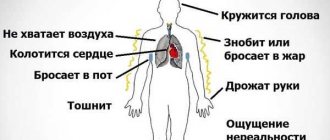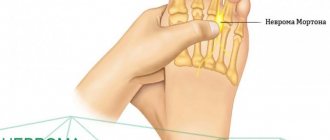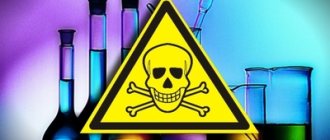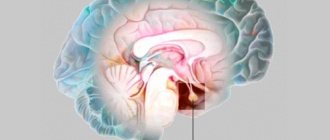This article is about a form of schizophrenia. For other paranoid psychoses, see paranoid psychosis; for a similar delusional disorder, but without the accompanying disorganization of thinking of the schizophrenic type and hallucinations, see paranoia; For the personality disorder, see paranoid personality disorder.
| Paranoid schizophrenia | |
| ICD-10 | 20.020.0 |
| ICD-9 | 295.3295.3 |
| MeSH | D012563 |
Paranoid schizophrenia
- a type of schizophrenia characterized by the dominance of hallucinations and (or) delusions, while intermittent speech, affective flattening and catatonic symptoms may be present in a mild form, but are not the main ones in the clinical picture [1]. The paranoid type of schizophrenia is the most common[2]. The peculiarity of this type is the obligatory presence of delusions of paraphrenic, paranoid or paranoid types[2]. Characterized by a predominance of hallucinatory-paranoid clinical pictures, less pronounced deficit symptoms and a later onset compared to other forms of schizophrenia[3] (usually around 25-35 years, but may be later[4]). Behavior is characterized by hostility and aggressiveness[3][5], suspicion[3][5], tension[3][5], intolerance[4], irritability[4].
The term "paranoid schizophrenia"
found mainly in fiction and used by non-professionals.
In the Russian translation of the International Classification of Diseases approved by the Ministry of Health of Russia, this form of schizophrenia is called “paranoid
,” as in the vast majority of psychiatric reference books and manuals.
Content
- 1 Basic information 1.1 Stages of disease development
- 1.2 Western researchers about the clinic of schizophrenia
- 1.3 Oneiric conditions
- 1.4 Affective disorders
- 3.1 ICD-9
Schizophrenia associated with pregnancy and childbirth
Very often, symptoms of schizophrenia occur in women in connection with childbirth. Postpartum depression can be so severe at this time that it does not allow you to feel the joy of motherhood. After the symptoms of such depression pass, alienation towards one's own child remains. Some of the women in this state deny even that they had a child. Childbirth itself resembles only pain, torment and problems.
In this situation, the child suffers greatly because he lacks the attention, care and love of his mother. To compensate for this, other family members need to be more attentive to the baby.
Sluggish schizophrenia can develop into a reactive form of the disease. In this case, the woman experiences hallucinations and delusions. The baby should be protected during this time, since the mother may inflict fatal wounds during hallucinations.
basic information
Paranoid schizophrenia manifests itself mainly through disturbances in thinking processes, which are expressed mainly in distorted perceptions or paranoid behavior and thinking[6].
The clinical picture is characterized by relatively stable, usually paranoid delusions[7]. Paranoid schizophrenia is most often manifested by delusions of persecution, grandeur, relationship, influence, and sometimes other delusions, such as delusions of jealousy, erotic or hypochodriac delusions [4]. Delusional attitudes arise either acutely, as an insight, or gradually in the process of personality restructuring[2]. Auditory hallucinations are observed more often than tactile, olfactory and gustatory hallucinations[4]. Catatonic symptoms, volitional and speech disorders, as well as emotional disorders are usually mild[7].
Paranoid schizophrenia may be accompanied by excessive religiosity[8].
There is a decrease in mental activity (decreased energy potential).
Patients with paranoid schizophrenia with depressive-delusional symptoms may exhibit persistent suicidal activity [4].
Sometimes two types of the course of paranoid schizophrenia are distinguished: hallucinatory (pseudohallucinatory) and delusional, depending on the predominance of one or the other in the disease picture [9]. L. M. Elgazina (1958) and E. D. Sokolova (1967) also identified these variants of the course (that is, hallucinosis and the predominance of delusional disorders). L.M. Elgazina argued that even at the initial stage of the development of the disease, it is possible to determine the hallucinatory-delusional or delusional variant of the development of the disease.
Stages of disease development
With delirium of influence in Kandinsky-Clerambault syndrome, the patient may feel the influence of, for example, a psychotronic weapon, from which a tin foil hat saves him.
Paranoid schizophrenia usually goes through several stages, with a stereotype of the development of the disease noted: initial, paranoid (the stage of delusion not accompanied by hallucinations and phenomena of mental automatism), paranoid (the stage of delusion with unsystematized delusional ideas of polythematic content and hallucinations, or Kandinsky-Clerambault syndrome with ideas exposure), paraphrenic (fantastic delirium), and the end of the disease - a pronounced schizophrenic defect [9]. However, a consistent change of psychopathological syndromes in paranoid schizophrenia is not necessary and is not always observed [10]:11. The literature describes rapid cases of the transition of paranoid syndrome to paraphrenic (paraphrenic) syndrome, bypassing the paranoid and hallucinatory-paranoid stage; such cases indicate an unfavorable course of the disease[10]:105.
The initial stage of the disease can be manifested by psychopathic-like disorders (disorders that are similar to personality disorders), depersonalization, obsessions, senestopathies or hypochondria [9]. Some patients in the initial stage experience distrust, a narrowing of their range of interests, dullness of emotional reactions and rigidity[9]. In the hallucinatory variant of paranoid schizophrenia, psychopath-like (pseudopsychopathic) and neurosis-like (pseudo-neurotic) disorders may be observed at the initial stage[9]. The duration of the initial period can be from 10 years or more[9].
When the manifestation of the disease occurs, interpretative delusions usually appear with varying degrees of systematization of delusional ideas[9]. Systematized interpretative delirium can be accompanied by hyperbulia, that is, increased volitional activity of patients: patients with delusions of invention or reformism turn to all sorts of authorities in order to immediately implement their ideas, patients with delusions of persecution strive to discover their enemies, patients with delusions of jealousy do everything possible to expose their imaginary rivals etc.[9] Sometimes psychoses, which are characterized by a high degree of systematization of monothematic delirium, drag on for a fairly long time; for these cases, a special subtype of paranoid schizophrenia is distinguished - paranoid schizophrenia [9]. Paranoid schizophrenia, as adapted for use in the Russian Federation, is coded F22.82 and belongs to the group of delusional disorders.
Then the paranoid stage may be replaced by Kandinsky-Clerambault syndrome, which may be preceded by emerging mental automatisms, anxious-fearful arousal, a feeling of fear and impending danger [9]. This syndrome can be formed in different ways: sometimes delusional disorders with one or two types of mental automatisms arise, and sometimes, in addition to delusions of influence and persecution, ideational or other types of mental automatisms develop with a gradual expansion of their range and the formation of a complete syndrome of mastery[9].
This is followed by the stage of paraphrenia - paraphrenic syndrome. The appearance of signs of paraphrenia in the clinical picture of Kandinsky-Clerambault syndrome occurs gradually [9]. In this case, ideas of influence can change from harmful to “benevolent”, and the background mood increases. Subsequently, delusions of grandeur of fantastic and absurd content arise (the patient, for example, may believe that he is entrusted with a special mission, that he influences the destinies of all people and even the Universe, etc.)[9].
The last stage is the schizophrenic defect (defective state), or final state. With it, schizophasia can be observed (a phenomenon when speech is grammatically constructed correctly, but is devoid of any meaning or content)[9]. The behavior of patients with schizophasia is usually orderly and outwardly correct[9].
Western researchers about the clinic of schizophrenia
Karl Kleist (1947) identified the following forms of paranoid schizophrenia: typical, atypical, extensive and combined[10]:14. In atypical and combined forms, a remitting course was most often observed [10]:14.
Gohe Alfred[en] (1934) considered the hallmark of paranoid schizophrenia to be personality changes that precede delusional experiences[10]:14. In his opinion, paranoid schizophrenia is less characterized by the systematization of delusions; its development is rather acute, and as the disease progresses, the delirium becomes increasingly incoherent and strange [10]:14.
Karl Leonhard (1957) divided endogenous psychoses into many forms, while he attributed paranoid psychoses to systematized schizophrenia, the forms of paraphrenia that Emil Kraepelin identified - to paranoid schizophrenia[10]:14.
G. Benedetti (1962) indicated a syndrome characteristic of paranoid schizophrenia - hallucinatory-paranoid syndrome[10]:16. According to his research, the onset of the disease can be acute or slow, and the course can be linear or wavy[10]:16. Benedetti classified all known forms of paraphrenia as paranoid schizophrenia[10]:16.
Oneiric conditions
See also: Oneiric syndrome
In paranoid schizophrenia, oneiric syndrome can also be observed. T. A. Klimusheva (1965) described the features of oneiric states in paranoid schizophrenia with Kandinsky-Clerambault syndrome[10]:9. In the patients she observed, oneiric states were in the form of an “oriented” oneiroid, were short in duration, characterized by a feeling of “doneness,” and their development occurred against the background of transient hallucinatory-delusional confusion or catatonic symptoms [10]: 9.
At the onset of the disease, the course of oneiric states occurred within the framework of visual pseudohallucinations; they were short-term, undeveloped and affectively (emotionally) intense[10]:10. Oneiric states at the stage of a pronounced process have a complex structure with true hallucinations, delusions of special significance or delusions of staging, as well as false recognitions.
Oneiric and similar experiences in paranoid schizophrenia are also described by such authors as V. N. Favorina (1959), M. P. Podobed (1969), G. N. Shumsky (1974), S. M. Lifshits (1965) [10]:10.
Wilhelm Mayer-Gross[en] described a patient with paranoid schizophrenia with oneiric disorder experiencing the End of the World[10]:13. In this case, the psychosis was constantly being reduced, and the depressive-paranoid syndrome came to the fore, which consisted of delusional perception in the form of delusions of sinfulness (characteristic of depressive states) and delusions of persecution [10]:13. With this clinical example, Mayer-Gross emphasized the difficulty of dividing paranoid schizophrenia into clinical forms, justifying this by the existence of transitional forms and the diversity of its psychopathological manifestations [10]: 13.
Affective disorders
See also: Post-schizophrenic depression
In paranoid schizophrenia, affective disorders (mood disorders) also occur: hypomania, mania, erased depression, gloomy-angry mood and affective fluctuations[10]:9. Elevated mood usually precedes the onset of the paraphrenic stage of paranoid schizophrenia[10]:9.
M. V. Sivanova and E. N. Efremova (1973) described the features of manic syndrome in 30 patients with paranoid schizophrenia[10]:10. In 16 patients, manic syndrome was accompanied by paraphrenic syndrome, in 8 it was noted at the onset of psychosis, in the remaining 6 it arose during therapy with antipsychotic drugs (and was short-term)[10]:10.
Typical signs of schizophrenia in women
Female schizophrenia is characterized by a multifaceted clinical picture. It usually starts later than the male form, at the age of 25-30, and proceeds more mildly, so it is tolerated more easily and compensated by the fair sex.
Signs of schizophrenia in women correspond to the classic manifestations of the disorder, and can also acquire specific features.
Each case is individual, and there are also severe cases of the disorder that provoke a complete collapse of the personality.
Peculiarities
Schizophrenia in women goes through several stages of development, corresponding to the standard stages of the disorder:
Useful article? Don't miss new ones! Enter your email and receive new articles by email
Source: https://dnevnyk-uspeha.com/psihologiya/priznaki-shizofrenii-u-zhenshhin.html
Classification
ICD-9
According to the International Statistical Classification of Diseases, Injuries and Causes of Death, 9th revision (ICD-9), adapted for use in the USSR, paranoid schizophrenia had a number of clinical variants: 295.31295.31 - paranoid form (unfavorable variant), 295.32295.32 - paranoid form (typical variant), 295.33295.33 - paranoid form (paroxysmal-progressive course), 295.39295.39 - paranoid form with an unspecified type of course [11]. Separately, 295.53295.53 stood out - sluggish paranoid (paranoid) schizophrenia, which was a subtype of sluggish schizophrenia [11].
ICD-10
This section is transcribed from Schizophrenia. (edit | history)
Below are the official general criteria for paranoid, hebephrenic, catatonic and undifferentiated schizophrenia (F20.0-F20.3)[12]. According to ICD-10, to make a diagnosis, at least one of the following signs must be observed:
- (a) “Echo” of thoughts (the sound of one’s own thoughts), putting or taking away thoughts, openness of thoughts to others.
- (b) Delusions of mastery, influence, or passivity, distinctly relating to the body or limbs, thoughts, actions, or sensations; delusional perception.
- (c) Hallucinatory "voices" commenting or discussing the patient's behavior; other types of "voices" coming from different parts of the body.
- (d) Persistent delusions that are culturally inappropriate, absurd, impossible, and/or grandiose in content.
Or at least two of the following “lesser” symptoms must be observed:
- (e) Persistent hallucinations of any kind, if they occur daily for at least one month and are accompanied by delusions (which may be unstable and semi-formed) without a distinct affective content.
- (f) Neologisms, sperrungs (breaks in thinking), leading to discontinuity or inconsistency in speech.
- (g) Catatonic behavior such as agitation, rigidity or waxiness, negativism, mutism and stupor.
- (h) “Negative symptoms” (but not caused by depression or pharmacotherapy), usually leading to social withdrawal and decreased social performance; symptoms that can be expressed: apathy
- speech impoverishment or smoothness
- inadequacy of emotional reactions
Diagnostic instructions
In this case, these symptoms should be observed for at least a month. Conditions that meet these criteria but last less than a month are classified as acute schizophrenia-like psychotic disorder (23.223.2 with an additional fourth character indicating the nature of the disorder), and if they subsequently continue for more than a month, the diagnosis is changed (recoded) to the corresponding form of schizophrenia[ 12].
When symptoms of schizophrenia develop together with severe symptoms of other disorders (affective: manic or depressive episodes, epileptic, other brain diseases, alcohol or drug intoxication or withdrawal syndrome), the diagnosis of schizophrenia is not made, and the appropriate diagnostic categories and codes are used. The diagnosis of schizophrenia is made if the case meets the criteria for a manic episode 30.- or a depressive episode (32.-), but the above general criteria are identified before
development of mood disorders[12].
Symptom (i) in the list above refers only to the diagnosis of “simple type of schizophrenia” (20.620.6), and a period of observation of symptoms by a psychiatrist of at least one year is required[12].
According to ICD-10, the diagnosis of paranoid schizophrenia is made when the following criteria are met:
- A. General criteria for schizophrenia should be identified (F20.0-F20.3).
- B. Delusions and hallucinations must be significant (such as delusions of persecution, meaning and relationship, high kinship, special mission, bodily change or jealousy; “voices” of a threatening or imperative nature, olfactory or gustatory hallucinations, sexual or other bodily sensations).
- B. Emotional flatness or inadequacy, catatonic symptoms or interrupted speech should not dominate the clinical picture, although they may be present in mild severity.
Original text (English)
- A. The general criteria for Schizophrenia (F20.0—F20.3 above) must be met.
- B. Delusions or hallucinations must be prominent (such as delusions of persecution, reference, exalted birth, special mission, bodily change or jealousy; threatening or commanding voices, hallucinations of smell or taste, sexual or other bodily sensations).
- C. Flattening or incongruity of affect, catatonic symptoms, or incoherent speech must not dominate the clinical picture, although they may be present to a mild degree.
— International Classification of Diseases, Tenth Revision (ICD-10)[13]
Differential diagnosis
It is important to rule out acute transient psychotic disorder, schizoaffective disorder, chronic delusional disorder, and organic delusional disorder. In acute transient psychotic disorders, negative and positive symptoms of schizophrenia may be present, but they usually resolve within 2 weeks. It is important to exclude the fact of induced delusions, which may be present, for example, when raising children in a family with mental illness.
Delusions in schizophrenia differ from delusions in delusional disorder in their absurdity and pretentiousness, polythematicity and fragmentation [4].
Variants of the course and designation of remission
The course of paranoid schizophrenia can be chronic (continuous) or episodic (paroxysmal) with partial or complete remission.
Types of disease progression are coded by adding a fifth character[14]:
- continuous F20.00;
- episodic with increasing defect F20.01;
- episodic with stable defect F20.02;
- episodic remitting (recurrent) F20.03;
- incomplete remission F20.04;
- complete remission F20.05;
- other F20.08;
- The course is unclear, the observation period is insufficient F20.09.
In the ICD-10 version adapted for use in the Russian Federation, “other course” is designated by code F20.07, and code F20.09 is an observation period of less than a year.
A. V. Snezhnevsky noted that the concept of “continuous flow” is relative. In essence, all forms of schizophrenia, including continuous ones, “occur with periods of exacerbations and temporary lulls (remissions)” [15].
The presence or absence of remission in the adapted version is indicated by the sixth character of the code, and if there is remission, an indication of its nature [16]:
- F20.0x4 Paranoid schizophrenia, incomplete remission;
- F20.0x5 Paranoid schizophrenia, complete remission;
- F20.0x6 Paranoid schizophrenia, lack of remission;
- F20.0x8 Paranoid schizophrenia, other type of remission;
- F20.0x9 Paranoid schizophrenia, remission NOS.
DSM
The American Diagnostic and Statistical Manual of Mental Disorders, 2nd edition (DSM-II) included “paranoid type of schizophrenia” (manual code 295.3). There were 3 subtypes, depending on the predominant symptoms: hostile (hostile), grandiose (grandiose) and hallucinatory (hallucinatory) [17].
Diagnostic criteria for paranoid type of schizophrenia (295.3x) in DSM-III-R (3rd revised edition)[18]:
- A. The predominance of one or more systematized delusional systems or frequent auditory hallucinations associated with one topic.
- B. Absence of the following manifestations: incoherent speech, marked relief (inadequacy) of associations, flattened or significantly impaired affect, catatonic behavior, severely disorganized behavior.
Original text (English)
- A. Preoccupation with one or more systematized delusions or with frequent auditory hallucinations related to a single theme.
- B. None of the following: incoherence, marked loosening of associations, flat or grossly inappropriate affect, catatonic behavior, grossly disorganized behavior.
Diagnostic criteria for paranoid type of schizophrenia (295.30) in DSM-IV-TR (4th revised edition)[19]:
- A. Predominance of one or more delusional systems or frequent auditory hallucinations.
- B. Absence of the following: disorganized speech, catatonic or disorganized behavior, flattened or inappropriate affect.
Original text (English)
- A. Preoccupation with one or more delusions or frequent auditory hallucinations.
- B. None of the following is prominent: disorganized speech, disorganized or catatonic behavior, or flat or inappropriate affect.
The next edition of DSM-5 does not include types of schizophrenia[20][21].
Causes
The causes of paranoid schizophrenia, as well as other subtypes, are not reliably known. Research shows that most forms of schizophrenia are caused by brain dysfunction. This is true, but it is still unknown why this brain dysfunction occurs. It is most likely caused by a combination of genetic and environmental triggers.
Experts believe that an imbalance of a neurotransmitter such as dopamine is most often to blame for the occurrence of this disease. They also believe that the presence of such an imbalance is most likely due to certain genes that make a person more susceptible to the disease. Other scientists say that serotonin is also involved in this process.
Changes in the basic functions of the brain in this disease, such as perception, emotions and behavior, have led experts to the conclusion that the brain is the biological seat of this disease, but the reasons for its development in each individual person are purely individual.
The risk factors for this subtype are essentially the same as for most other subtypes:
- Genetics. People with a strong family history have a higher risk of developing this disease. If your family has never had this disease, then your chances of developing it are less than 1%. However, this risk increases to 10% if at least one of your parents had or has a schizophrenic relative;
- Viral infection. If the fetus is exposed to a viral infection in the womb, there is a greater risk of developing the disease;
- Fetal starvation. If the fetus suffers from malnutrition during the mother's pregnancy, the risk of development is also high;
- Stress experienced at an early age. Experts say severe stress early in life can be a big factor;
- Childhood abuse or trauma. Such events very often contribute to the onset of this disease;
- Age of parents. Older parents have a higher risk of having children who may later develop schizophrenia compared with younger parents;
- Drugs and alcohol. The use of substances that affect the brain or mental processes also causes the development of this mental illness.
Therapy
Acute overt psychosis in this disorder is treated with antipsychotic drugs and detoxification therapy[22]:158. The increase in negative disorders can be prevented by small doses of risperidone (up to 2 mg) and other antipsychotics, as well as insulin comatose therapy[22]:158. Risperidone and flupenthixol have shown effectiveness in treating patients with paranoid schizophrenia, including improving their cognitive abilities[23].
For maintenance therapy, long-term antipsychotics (haloperidol depot, liorodine depot) and lithium carbonate are used in the presence of affective disorders in the structure of psychosis [22]: 158.
In case of resistance to neuroleptic drugs, monolateral electroconvulsive therapy is used[22]:158.
Hallucinations
Women with schizophrenia, unlike men, are more likely to hallucinate. And more often they suffer from delirium. It is these signs of female schizophrenia that make it similar to a childhood and adolescent disease. The patient’s consciousness is filled with delusional ideas, and it is impossible to dissuade the woman from them. When delirium of physical influence occurs, this condition is difficult to treat.
Sometimes the patient may feel that she is not being influenced by hypnosis or other incredible methods. It often seems that a conspiracy is being hatched against the woman, and there are many enemies at work. Often pictures, and even entire films, appear in my head in which incredible creatures are present.
Often a woman's strange behavior is that she is hallucinating. This may result in unpleasant sounds and odors. There is a feeling of drilling, burning and even shooting in the head. It is very difficult to treat such hallucinations, and this can only be done by taking modern medications.
Personalities
Famous people who suffered from paranoid schizophrenia:
- John Forbes Nash is an American mathematician, winner of the 1994 Nobel Prize in Economics “for his analysis of equilibrium in the theory of non-cooperative games”[24][25].
- Daniel Paul Schreber is a German judge, famous for describing his condition in the book “Memoirs of a Neuropathological Patient”[26].
- Theodore Kaczynski, also known as the Unabomber, is a Ph.D. in mathematics and social critic known for his mail-in bomb campaign.[27]
- Mark David Chapman is the killer of John Lennon, member of The Beatles. Mark was diagnosed by Dr. Daniel Schwartz[28].
- Nikolai Dzhumagaliev - Soviet serial killer - cannibal, "Iron Fang".
- Richard Chase - American serial killer, "The Vampire of Sacramento". He suffered from hypochondriacal delirium.
- Lionel Aldridge (English) is an American professional football player[25][29].
- James Chassey (English) is an American writer and singer[30].
- Kevin Archer is an English guitarist and songwriter.[31]
- Parveen Babi is an Indian actress[25].
- Tom Harrell is an American jazz musician (trumpetist) and composer.[25]
- Bettie Page is an American fashion model[32].
- Veronica Lake is an American actress who has been awarded a star on the Hollywood Walk of Fame.[33]
Controversial or erroneous examination results:
- Peter Sutcliffe is a British serial killer. He was declared “no longer mentally ill” and sent from a psychiatric hospital to prison[34][35].
- Anders Behring Breivik was a Norwegian terrorist who was diagnosed with paranoid schizophrenia by two teams of court-appointed psychiatrists[36][37], but after widespread criticism of the initial reports, the case was reviewed and he was found sane[38][36]. A second psychiatric examination assessed his condition as a manifestation of narcissistic personality disorder combined with pathological fantasy (pathological lying), which does not exempt him from criminal liability[36].
Signs are emotional
Various signs of schizophrenia may be present, but the impetus for their development is emotional turmoil. Emotional signs in women increase as they develop. The very first of them is the loss of the ability to sympathize; there is no sympathy even for close and dear people. For a person with schizophrenia, the meaning of everything is lost, even in his family. She may perceive her family as strangers.
A woman loses interest in her profession, is not interested in anything, and is rejected from the outside world. Reflection often occurs, which means that a woman begins to look for the meaning of life, and philosophizes on this topic even in the most insignificant situations.
The signs described above are symptoms of a mild course of the disease, but there are also those that are more widespread. In this case, the woman begins to show aggression, rudeness, anger, and this even towards close people. In this case, promiscuity and vagrancy may occur. The patient may stop caring for herself.
The phrase told to a woman that she should start treating schizophrenia is received with hostility. But women admit the disease more easily than men, who think that they are absolutely healthy. Women understand that their life has worsened or they feel that an evil spirit has entered their body. But despite all the assessment of the condition, the woman cannot control her behavior. Sometimes such a woman can perceive illness as signs from above, and at the same time engage in the occult or magic. In this state, the disease is much more difficult to treat, if at all.
Notes
- V. N. Krasnov.
Chapter 21. Schizophrenia. Diagnosis of schizophrenia // Psychiatry: national guide / ed. T. B. Dmitrieva, V. N. Krasnova, N. G. Neznanova, V. Ya. Semke, A. S. Tiganova. - M.: GEOTAR-Media, 2011. - P. 449. - 1000 p. — ISBN 978-5-9704-2030-0. - ↑ 1 2 3 Bacherikov N. E.
Clinical psychiatry. — K.: Health. — ISBN 5311003340. - ↑ 1 2 3 4 Yu. V. Popov, V. D. Vid.
Modern clinical psychiatry. - M.: Expert Bureau-M, 1997. - P. 99. - 496 p. — ISBN 5-86065-32-9. - ↑ 1 2 3 4 5 6 7 V. L. Minutko.
Paranoid form // Schizophrenia. - JSC "IPP Kursk", 2009. - ISBN 978-5-7277-0490-5. - ↑ 123
Psychiatry / ed. N. G. Neznanov, Yu. A. Aleksandrovsky, L. M. Bardenshtein, V. D. Vida, V. N. Krasnov, Yu. V. Popov. - M.: GEOTAR-Media, 2009. - P. 119. - 512 p. — (“Clinical guidelines”). — ISBN 978-5-9704-1297-8. - Verna Benner Carson.
Mental health nursing: the nurse-patient journey. - 2. - WB Saunders, 2000. - P. 642. - 1182 p. — ISBN 0721680534, 9780721680538. - ↑ 1 2 A. P. Chuprikov, A. A. Pedak, O. M. Linev.
Schizophrenia: Clinic, diagnosis, treatment. — P. 26. - Clinical psychiatry / Ed. ed. T. B. Dmitrieva. - M.: GEOTAR-Media, 1998. - 477 p.
- ↑ 1 2 3 4 5 6 7 8 9 10 11 12 13 14 15 Orlovskaya and others.
Guide to psychiatry in 2 volumes / Ed. Academician of the Russian Academy of Medical Sciences A. S. Tiganov. - M.: Medicine, 1999. - T. 1. - P. 425-428. — 712 p. — ISBN 5-225-02676-1. - ↑ 1 2 3 4 5 6 7 8 9 10 11 12 13 14 15 16 17 18 19 20 21 22 23 Alimkhanov Zh. A.
schizophrenia (Structure and dynamics of delusional syndromes). - Alma-Ata: Kazakhstan, 1987. - 160 p. - ↑ 1 2 World Health Organization.
Section V of the “International Statistical Classification of Diseases, Injuries and Causes of Death, 9th Revision”, adapted for use in the USSR. - M., 1983. - P. 26-29. - ↑ 1 2 3 4 World Health Organization.
The ICD-10 Classification of Mental and Behavioral Disorders. Clinical descriptions and diagnostic guidelines. — Jeneva. — P. 78-79. — 267 p. (English) - World Health Organization.
The ICD-10 Classification of Mental and Behavioral Disorders. Diagnostic criteria for research. - Geneva. — P. 79. - World Health Organization.
The ICD-10 Classification of Mental and Behavioral Disorders. Clinical descriptions and diagnostic guidelines. - Geneva. — P. 76-77. — 267 p. - A. V. Snezhnevsky.
The course and psychoses of schizophrenia in late life. - M., 1981. - World Health Organization.
International Classification of Diseases (10th revision). Class V: Mental and behavioral disorders (F00-F99) (adapted for use in the Russian Federation). - Rostov-on-Don: Phoenix, 1999. - P. 114. - ISBN 5-86727-005-8. - American Psychiatric Association.
Diagnostic and Statistical Manual of Mental Disorders, Second Edition (DSM-II). - Washington, DC: American Psychiatric Publishing, 1968. - P. 34. - American Psychiatric Association.
Diagnostic and Statistical Manual of Mental Disorders, Third Edition, Revised (DSM-III-R). - Washington, DC: American Psychiatric Publishing, 1987. - P. 197. - ISBN 0521-34509-X ISBN 0-521-36755-6. - American Psychiatric Association.
Diagnostic and Statistical Manual of Mental Disorders, Fourth Edition, Text Revision (DSM-IV-TR). - Washington, DC: American Psychiatric Publishing, 2000. - P. 314. - ISBN 978-0-89042-025-6. - John M. Grohol, Psy.D.
DSM-5 Changes: Schizophrenia & Psychotic Disorders - Highlights of Changes from DSM-IV-TR to DSM-5 (English)
- ↑ 1 2 3 4 Samokhvalov V.P.
Psychiatry (Textbook for students of medical universities). - Rostov-on-Don: Phoenix, 2002. - 575 p. — (Series “Higher Education”). — ISBN 5-222-02133-5. - V. B. Vilyanov, A. L. Hamburg, V. A. Rassnyuk.
Comparative effectiveness of the use and influence on cognitive functions of risperidone and flupenthixol in patients with paranoid schizophrenia // Psychiatry and psychopharmacotherapy named after. P.B. Gannushkina. - 2000. - T. 2, issue. 5. - pp. 148-152. - Teri Shors.
Understanding Viruses. - Jones & Bartlett Publishers, 2020. - P. 701. - ISBN 978-1-284-02592-7. - ↑ 1234
Famous People with Schizophrenia (English). Disabled World. Retrieved March 11, 2020. - J. Michael Mahoney.
Schizophrenia: The Bearded Lady Disease. - AuthorHouse, 2011. - P. 290. - ISBN 978-1-4670-6302-9. - Lynn E. DeLisi.
100 Questions & Answers About Schizophrenia: Painful Minds. - Jones & Bartlett Learning, 2006. - P. 88. - ISBN 978-0-7637-3654-5. - Jay Robert Nash.
Murder among the rich and famous: celebrity slayings that shocked America. - Random House Value Publishing, 1988. - P. 294. - ISBN 978-0-517-63218-5. - Eskenazi, Gerald
. Lionel Aldridge, 56, Stalwart On Defense for Packer Teams (February 14, 1998). Retrieved August 10, 2012. (English) - Why Did James Chasse die?. Portland Tribune (September 11, 2008). Retrieved January 6, 2013. Archived June 7, 2011. (English)
- Stephen Troussé (2012) "Let's Make This Precious!", Uncut Magazine
, June 2012, p. 30 - Richard Foster.
The Real Bettie Page: The Truth about the Queen of the Pinups. - Carol Publishing Group, 1997. - P. 131. - ISBN 978-1-55972-432-6. - Lucy Barry Robe.
Co-starring famous women and alcohol. - CompCare Publications, 1986. - ISBN 978-0-89638-100-1. - Yorkshire Ripper Peter Sutcliffe moved from Broadmoor to prison, BBC News (25 August 2016). Retrieved March 11, 2020.
- Yorkshire Ripper moved back to prison from psychiatric hospital, The Huddersfield Daily Examiner
(25 August 2016). Retrieved March 11, 2020. - ↑ 1 2 3
Melle I. (2013).
"The Breivik case and what psychiatrists can learn from it." World Psychiatry 12
(1): 16–21. DOI:10.1002/wps.20002. PMID 23471788. Translation: The Breivik case and the lessons psychiatrists can learn from it - Ole N. Olsen, David Andresen Vesteng
.
Rettspsykiaterne beskriver bisarre vrangforestillinger hos Breivik (Norwegian), Verdens Gang
(29 November 2011). Retrieved January 6, 2013. (Norwegian) - Norway killer Breivik is 'not psychotic', say experts, BBC (4 January 2012). Retrieved January 6, 2013. (English)
Sluggish schizophrenia
Classic schizophrenia leads to complete personality degradation , while sluggish schizophrenia only changes personal characteristics, deforming them. The development of a sluggish form of the disease makes its own adjustments to personal characteristics.
The disease can be provoked by psychological trauma, stress or poor lifestyle . A woman suffering from this form of schizophrenia does not necessarily need treatment and symptom relief; the condition can improve on its own.
Men and women are equally susceptible to sluggish schizophrenia, but in the fairer sex, this disease often manifests itself at a later age. The peculiarity of this disease in men is the continuous form of the disease, while in women the disease more often occurs in paroxysms.
Symptoms of schizophrenia are more often noticed in men; negligence and lack of desire to take care of oneself make the disease very noticeable to others. Women also experience these symptoms, but they are immediately noticeable, even at an early stage of the disease.
A low-grade form of schizophrenia can change a woman’s personality for decades. This disease is little noticeable to others due to the absence of acute phases of psychosis. Of course, close people will always notice the metamorphoses occurring with a loved one, long-term states of neuroses and other mental manifestations. However, people with such a disease are quite capable of working and caring for themselves independently.
Complications and consequences
Schizophrenia, the symptoms of which in women are mild, does not cause serious harm to health. Stages of remission are rarely followed by periods of exacerbations. It doesn't go as far as delusions and hallucinations. Negative symptoms will progress slowly, without leading to the development of acute psychosis.
The manic form of the disorder is very dangerous. Obsessive ideas and delusions of persecution come to the fore. At peak moments, a person can cause harm to himself and others. Often it comes to suicide.
Other consequences of schizophrenia include:
- Obesity or anorexia
- Memory loss, dementia.
- Insomnia, nightmares, chronic fatigue.
- Depression after an acute attack of schizophrenia. Symptoms of the underlying disease may be completely absent, with a depressed mood coming to the fore.
- Parkinsonism.
- Inability to socially interact.
- Diseases of the cardiovascular system.
- Loss of ability to work.
Schizophrenia is dangerous not only for a woman’s personality, but also for the people around her. Therefore, during an exacerbation of a severe form of pathology, hospitalization is required.











